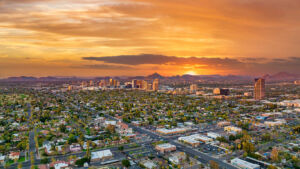The recent rejuvenation of Tucson’s downtown district helps attract Millennials and outside interests to Southern Arizona where the climate is ripening for growth and economic development.
“The climate is swinging towards a more predevelopment attitude and a lot of it has to do with the national economy,” said David Ollanik, Sundt Construction project director in Tucson.
Downtown remains a hot spot for commercial expansion, but several other projects are in the pipeline across the city to meet growing needs for housing, goods, services and infrastructure.

Courtesy of Shepley Bulfinch
 “We have a thriving central business district that is attractive to Millennials,” said Barbi Reuter, chief operating officer for Cushman and Wakefield, PICOR. “That really sets a tone for the market.”
“We have a thriving central business district that is attractive to Millennials,” said Barbi Reuter, chief operating officer for Cushman and Wakefield, PICOR. “That really sets a tone for the market.”
The Tucson market is primed for the construction of new multimillion-dollar facilities in the commercial and medical sectors, as well as moves by new companies into existing commercial spaces.

Companies like Sunquest Information Systems, a global leader in the laboratory and diagnostic solutions, chose Tucson for its new headquarters. Sunquest signed an 11-year lease to occupy the 83,000 square feet of office space that was formerly the Muscular Dystrophy Association headquarters, and will employ between 180 and 200 people.
Other companies such as HomeGoods, a store offering off-price home fashions, picked Tucson as the site for constructing its new 800,000-square-foot West Coast distribution center, which has already broken ground. The project is anticipated to create up to 900 jobs, with a total economic impact of $873 million.
Joe Snell, president and CEO of Sun Corridor Inc., said, “This win builds on the success of other name brands who have recognized that locating in Southern Arizona makes economic sense, such as Target.com, La Costeña/Arizona Canning Company and others.”
Reuter mentioned other outside interests are taking note of the economic benefits of moving to Southern Arizona. “We hear Tucson is on the shortlist for more major firms,” she explained.
In the meantime, Reuter said the medical office market is one sector where Tucson is seeing the most growth and opportunity.
Tucson Medical Center and Banner-University Medical Center both plan to expand with construction of new facilities on opposite sides of town to provide medical services and offices for physicians.

TMC will construct a 40,000-square-foot medical building at Houghton and Drexel roads to meet under-served healthcare needs on the southeast side of town. Banner-UMC, one of the nation’s top academic medical centers, will build a nine-story patient tower at its current location north of the University of Arizona’s campus.
Other noteworthy projects include a facelift to the Tucson airport and Pima County animal shelter.
The Tucson International Airport Optimization Project will relocate security checkpoints, upgrade the infrastructure and open more concession spaces to increase airport revenue. Sundt Construction expects the project to be completed by 2017.

Sundt was also contracted by Pima County to design and build a new Pima Animal Care Center after voters approved the project in 2014. It will replace the old center that was built in 1968.
Ollanik said, overall, the business community would like to see the market progress more quickly, but it is moving in the right direction.
“It’s going to move along at a slow and steady pace,” he added.



